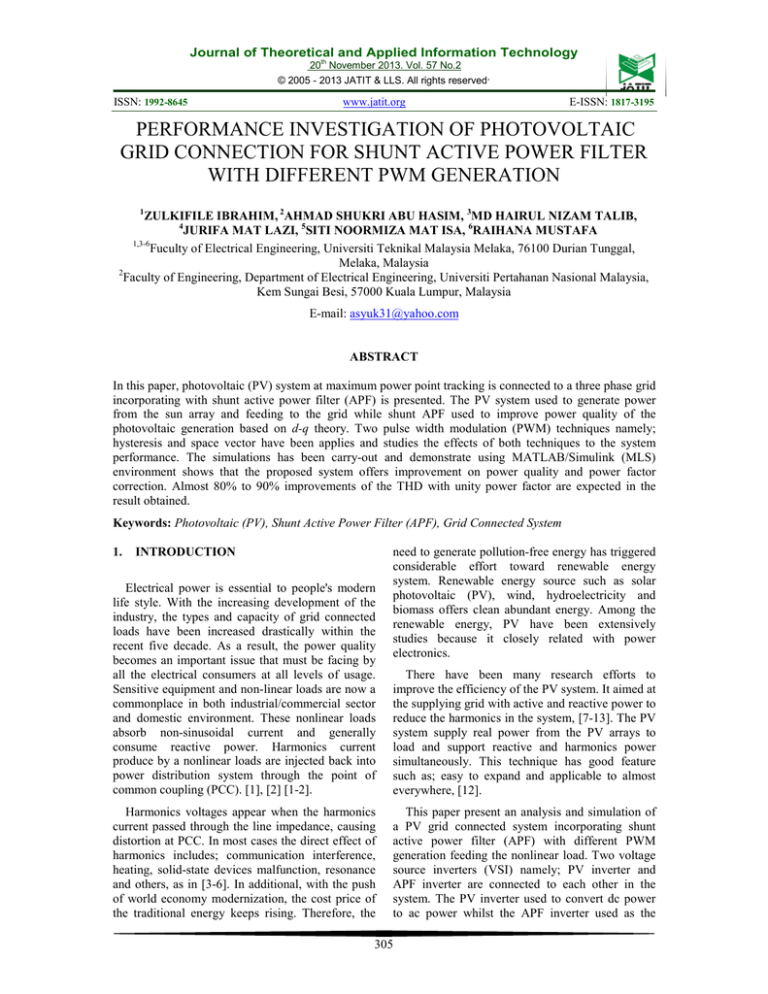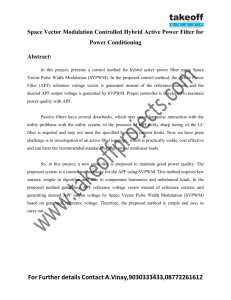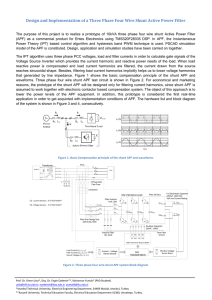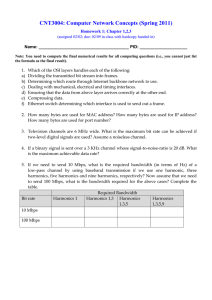
Journal of Theoretical and Applied Information Technology
20th November 2013. Vol. 57 No.2
© 2005 - 2013 JATIT & LLS. All rights reserved.
ISSN: 1992-8645
www.jatit.org
E-ISSN: 1817-3195
PERFORMANCE INVESTIGATION OF PHOTOVOLTAIC
GRID CONNECTION FOR SHUNT ACTIVE POWER FILTER
WITH DIFFERENT PWM GENERATION
1
ZULKIFILE IBRAHIM, 2AHMAD SHUKRI ABU HASIM, 3MD HAIRUL NIZAM TALIB,
4
JURIFA MAT LAZI, 5SITI NOORMIZA MAT ISA, 6RAIHANA MUSTAFA
1,3-6
Fuculty of Electrical Engineering, Universiti Teknikal Malaysia Melaka, 76100 Durian Tunggal,
Melaka, Malaysia
2
Faculty of Engineering, Department of Electrical Engineering, Universiti Pertahanan Nasional Malaysia,
Kem Sungai Besi, 57000 Kuala Lumpur, Malaysia
E-mail: asyuk31@yahoo.com
ABSTRACT
In this paper, photovoltaic (PV) system at maximum power point tracking is connected to a three phase grid
incorporating with shunt active power filter (APF) is presented. The PV system used to generate power
from the sun array and feeding to the grid while shunt APF used to improve power quality of the
photovoltaic generation based on d-q theory. Two pulse width modulation (PWM) techniques namely;
hysteresis and space vector have been applies and studies the effects of both techniques to the system
performance. The simulations has been carry-out and demonstrate using MATLAB/Simulink (MLS)
environment shows that the proposed system offers improvement on power quality and power factor
correction. Almost 80% to 90% improvements of the THD with unity power factor are expected in the
result obtained.
Keywords: Photovoltaic (PV), Shunt Active Power Filter (APF), Grid Connected System
1.
INTRODUCTION
Electrical power is essential to people's modern
life style. With the increasing development of the
industry, the types and capacity of grid connected
loads have been increased drastically within the
recent five decade. As a result, the power quality
becomes an important issue that must be facing by
all the electrical consumers at all levels of usage.
Sensitive equipment and non-linear loads are now a
commonplace in both industrial/commercial sector
and domestic environment. These nonlinear loads
absorb non-sinusoidal current and generally
consume reactive power. Harmonics current
produce by a nonlinear loads are injected back into
power distribution system through the point of
common coupling (PCC). [1], [2] [1-2].
Harmonics voltages appear when the harmonics
current passed through the line impedance, causing
distortion at PCC. In most cases the direct effect of
harmonics includes; communication interference,
heating, solid-state devices malfunction, resonance
and others, as in [3-6]. In additional, with the push
of world economy modernization, the cost price of
the traditional energy keeps rising. Therefore, the
need to generate pollution-free energy has triggered
considerable effort toward renewable energy
system. Renewable energy source such as solar
photovoltaic (PV), wind, hydroelectricity and
biomass offers clean abundant energy. Among the
renewable energy, PV have been extensively
studies because it closely related with power
electronics.
There have been many research efforts to
improve the efficiency of the PV system. It aimed at
the supplying grid with active and reactive power to
reduce the harmonics in the system, [7-13]. The PV
system supply real power from the PV arrays to
load and support reactive and harmonics power
simultaneously. This technique has good feature
such as; easy to expand and applicable to almost
everywhere, [12].
This paper present an analysis and simulation of
a PV grid connected system incorporating shunt
active power filter (APF) with different PWM
generation feeding the nonlinear load. Two voltage
source inverters (VSI) namely; PV inverter and
APF inverter are connected to each other in the
system. The PV inverter used to convert dc power
to ac power whilst the APF inverter used as the
305
Journal of Theoretical and Applied Information Technology
20th November 2013. Vol. 57 No.2
© 2005 - 2013 JATIT & LLS. All rights reserved.
ISSN: 1992-8645
www.jatit.org
harmonics compensation hence reduce lowfrequency ripple problem in the system, [14]. The
control algorithm for harmonics detection is based
on synchronous rotating frame (SRF) to adjustment
of the active and reactive power. The control of
active and reactive power is based on the current
control in d-q rotating reference system. Two PWM
generations are used in this system to compares the
performances of the APF namely are space vector
modulation control and hysteresis current control.
2.
These equations are referring to Fig. 2 for single
PV cell.
𝐼𝑠𝑐 (𝑇) − 𝐼𝑠𝑐 𝑇𝑟𝑒𝑓
𝑇 − 𝑇𝑟𝑒𝑓
𝐼𝐷 = 𝐼𝑜 �𝑒
Shunt APF
+
-
Rs
(3)
𝐺
𝐼 �𝑇 �
𝐺𝑟𝑒𝑓 𝑠𝑐 𝑟𝑒𝑓
(4)
𝑉𝐷
�𝑉
𝑇
− 1�
(5)
where; 𝑉𝐷 = 𝑉𝑐𝑒𝑙𝑙 (𝐼𝑐𝑒𝑙𝑙 𝑥 𝑅𝑠 )
Therefore, by using Ohm's law, the shunt current I sh
can be defined as;
2.1 Mathematical Modeling Of PV Cell And
Panel
The equivalent circuit of the PV cell is shown in
Fig. 2 which includes power supply and a diode.
ID
(2)
𝐺
𝑥 𝐼𝑠𝑐 �𝑇𝑟𝑒𝑓 �
𝐺𝑟𝑒𝑓
Diode current I D characteristic is given in Eq. (5)
where the I O is the diode saturation current, while
V T represents the thermal voltage.
Figure 1: Overall Proposed System
Iph
𝐼𝑝ℎ �𝑇𝑟𝑒𝑓 � =
𝐼𝑝ℎ = 𝐼𝑝ℎ �𝑇𝑟𝑒𝑓 � =
Grid
Vdc
(1)
Taking the consideration that the environment
temperature is set at nominal one, therefore the PV
current only depends on solar radiation which
represented in Eq. (4).
Nonlinear
Load
PV
System
𝐼𝑝ℎ = 𝐼𝑝ℎ �𝑇𝑟𝑒𝑓 � 𝑥 �1 + 𝐾0 �𝑇 − 𝑇𝑟𝑒𝑓 ��
𝐾0 =
PROPOSED SYSTEM
The overall proposed system is shown in Fig 1.
The mathematical model reflecting the electrical
quantities in the output of the PV cell and panel is
provided, as in [15], [16].
E-ISSN: 1817-3195
Icell
Ish
Rsh
+
𝐼𝑠ℎ =
𝑉𝐷
𝑅𝑠ℎ
(6)
Taking to account Eq. (1) and (5) and applying
Kirchhoff's current law, I-V characteristic for PV
are shown in Eq. (7)
𝐼𝑐𝑒𝑙𝑙 = 𝐼𝑝ℎ − 𝐼𝐷 − 𝐼𝑠ℎ
= 𝐼𝑝ℎ − 𝐼𝑜 �𝑒
Vcell
-
Figure 2: Equivalent Circuit Of A PV Cell
The photo current, I ph depends on the solar
radiation, G and the temperature, T of the
environment. This situation explains in Eq. (1),
[15]. I ph (T ref ) is the photo current at the nominal
temperature T ref . On the other hands, Eq. (2) gives
the formula of the photo current at the nominal
temperature. K 0 is a constant given in Eq. (3). G ref
and I sc are the nominal radiation given by the
constructor and short circuit current respectively.
𝑉𝐷
�𝑉
𝑇
− 1� − �
𝑉𝐷
�
𝑅𝑠ℎ
(7)
2.2 Maximum Power Point Tracker (MPPT)
The maximum power point tracker (MPPT)
produces maximum power under variable condition
of solar radiation and environmental temperature.
One of the most used methods of MPPT are the
perturb and observe (P&O). The main advantage of
this technique is that the search of the MPPT is
done independently on the environment condition,
however it required current and voltage sensor [12].
On the other hands, constant voltage methods is
used to keeping the voltage in the PV terminal
306
Journal of Theoretical and Applied Information Technology
20th November 2013. Vol. 57 No.2
© 2005 - 2013 JATIT & LLS. All rights reserved.
ISSN: 1992-8645
www.jatit.org
constant and closed to the MPPT line [16].
Therefore in this work, the PV terminal voltage is
set constant and at maximum value.
3.
SHUNT ACTIVE POWER FILTER
MODEL AND CONTROLLER
E-ISSN: 1817-3195
𝑖𝑑
𝑐𝑜𝑠𝜃
�𝑖 � = �
−𝑠𝑖𝑛𝜃
𝑞
where; 𝜃 = 𝑡𝑎𝑛−1 � �
𝑣𝛼
The phase angle, 𝜃 in d-q frame is same with
fundamental frequency which makes the DC
fundamental current component �𝑖𝑑� , 𝑖𝑞� � and
harmonics AC component �𝑖𝑑� , 𝑖𝑞� � arise due to
harmonics at the load [5]. By using low-pass filter
(LPF) the DC component can be obtained.
Subtracting the DC component with the previous
component can determine the harmonics
component for the system. Fig.4 shows the
techniques to determine the harmonics component
in the system.
ias
ibs
ics
ib
id
Low-pass filter
abc
d-q iq
ic
sin ωt
-cos ωt
iq
ia*
+
d-q
+
abc
ib*
+-
ic*
Low-pass filter
Inverter
ia* ia
Harmonics
Detection
Algorithm
Signal
Conditioning
+
-
ib* - ib
+
ic*
+
-
ic
Vasupply
Switching
Generation
Figure 3: Block Diagram Of Shunt APF
1�
√2
−1�
2
√3�
2
1�
√2 ⎤ 𝑖𝐿𝑎
−1� ⎥ �𝑖𝐿𝑏 �
2⎥
𝑖
−√3� ⎥ 𝐿𝑐
2⎦
sinωt
PLL cosωt
Figure 4: Harmonics Current Detection Using D-Q
Theory
3.1 Controller Design
The synchronous rotating frame or d-q theory
is used as the main controller design without
considering neutral wire. This method transforms
three-phase into d-q coordinates (rotating reference
frame with fundamental frequency) using Park
transformations. This theory is extensively used in
active filter because of the simplicity of the control
design [5, 17-19]. The equations to transform a-b-c
coordinate into α-β-0 coordinate is presented in Eq.
(8).
1
⎡ �√2
𝑖𝑜
2⎢
� 𝑖𝛼 � = � ⎢ 1
3
𝑖𝛽
⎢
⎣ 0
id
ia
to pcc
phase-lock
loop
(9)
𝑣𝛽
The shunt active power filter (APF) were
constructed with four essential elements in the
namely; (i) signal conditioning, (ii) reference
current generation, (iii) signal generation and (iv)
three-phase inverter. The signal conditioning circuit
used to provide accurate system information from
the voltage and current from the grid. The reference
current generator is used to generate the required
harmonics current to be amplified and injected into
the lines, at the point of common coupling (PCC).
The switching generation for the inverter is
generated at the controller circuit by comparing the
reference current (i a *, i b *, i c *) with the injected
currents (i a , i b , i c ). Fig. 3 shows the block diagram
of shunt APF.
(Vas)
𝑠𝑖𝑛𝜃 𝑖𝛼
�� �
𝑐𝑜𝑠𝜃 𝑖𝛽
(8)
By employing Park transformation, the α-β-0
coordinate is transform into d-q coordinate as
shown in Eq. (9)
3.2 Switching Techniques
Two switching techniques namely hysteresis
current control and space vector modulation control
are employs to generate the required pulse width
modulation (PWM) switching. Briefly explanations
of the switching techniques explain in the
subsequence.
3.2.1 Hysteresis Current Control
The earliest and most commonly proposed timedomain corrective technique is the hysteresis
method, as in [20-21]. Preset upper and lower
tolerance limits are compared to extracted error
signal. No switching action is taken as long as the
error is within the tolerance band. Switching action
occurs when the errors leaves the tolerance band.
These technique yields instantaneous and fast
response controller, [22].
The conditions of
switching devices are tabulated in Table I.
307
Journal of Theoretical and Applied Information Technology
20th November 2013. Vol. 57 No.2
© 2005 - 2013 JATIT & LLS. All rights reserved.
ISSN: 1992-8645
www.jatit.org
E-ISSN: 1817-3195
Non-liner
load
Table I: Hysteresis Band
Boost Converter
DC/AC Inverter
i ref - i act > HB
VSa
Upper switch on
Grid
Llc
iSc
iSb
iSa
i ref - i act < -HB
Lla
Llb
Vdc
VSc
Lower switch on
+
-
VSa
Hysteresis Band (HB)
VSb
Switch
To Inverter
IPV
IMPPT
Reference Signal
Switching
Genaration
Switching
Genaration
Phase
lock-loop
Voltage
Regulation
Harmonics
Detection
ia* ib* ic*
Hysteresis
Bands
S5
S3
ia -+
ib
-+
ic
-+
S1
Lfa
Lfb
Lfc
+
-
}
S2
S6
Switching
Genaration
S1 S2 S3 S4 S5 S6
S4
Figure 6: System Configuration
5.
Switching Pattern
SIMULATION RESULT
Figure 5: Hysteresis Method
3.2.2 Space Vector Modulation
Space Vector Modulation has been widely use in
APF system. This method have an advantages over
carrier based such as lower Total harmonics
Distortion (THD), higher efficiency easier digital
implementation and wider linear modulation range,
[23]. It is shown that in the linear range modulation,
the index modulation will goes high and reduce the
inverter DC link voltage in APF, [24]. In
implementation of SVM technique, there are TWO
(2) rules that must be followed. First rule, each leg
have two switches that cannot gated at the same
time and at least one switch must be turn "ON" due
to the system inductance. In this work a basic
switching vectors and sectors of hexagon axes
SVM technique is used for generate the PWM
4.
This section presents the general simulation
block diagram of the PV system connected to grid
incorporating with active power filter (APF)
feeding the nonlinear load in MLS environment.
Fig. 7 shows the six module PV arrays that used in
this system, while the overall simulation block
diagram shown in Fig. 8. The simulation
parameters of the PV module and the overall
parameters using in this simulation are tabulated in
Table II and Table III respectively.
MODELING OF PROPOSED SYSTEM
To carry out the analysis of the proposed system,
a simulation platform has been design. Fig. 6 shows
the simulation scheme of the PV system connected
to the three-phase grid system incorporating with
the shunt APF with non-linear load. The non-linear
load was constructed using full bridge rectifier
connected in parallel with a resistor and a capacitor
as the load. AC link inductors at the APF used to
attenuate the switching ripple hence prevent high
harmonics switching frequency. The phase- lockloop use to synchronize the harmonics phases with
the grid phases.
Figure 7: Six Module Of PV Array
308
Journal of Theoretical and Applied Information Technology
20th November 2013. Vol. 57 No.2
© 2005 - 2013 JATIT & LLS. All rights reserved.
ISSN: 1992-8645
www.jatit.org
E-ISSN: 1817-3195
Peak Current
Harmonics Spectrum of Load Current
7
6
5
4
3
2
1
0
1 2 3 4 5 6 7 8 9 10111213141516171819
No. of harmonics
Figure 9 : Harmonics Spectrum Of Load Current
Harmonics Spectrum of Compensation
Current
4
Peak Current
Figure 8: Simulation diagram of the PV grid connected
incorporating with shunt APF
Table 2 Parameters Of Pv Model
Parameters
Value
Short circuit current
5.45A
Open circuit voltage
22.2V
Current at Pmax
4.95A
Voltage at Pmax
17.2V
3
2
1
0
1 2 3 4 5 6 7 8 9 10 11 12 13 14 15 16 17 18 19
No. of Harmonics
Table 3 Simulation Parameters Of The System
Parameters
Value
Voltage Source
311 Vrms
DC link Voltage (V dc )
537V
DC link capacitor
C1=2000µF
Non-linear Load
R = 100Ω, C = 2000µF
DC Filter
L=1mH, C= 2300 µF
Filter Inductor (L F )
5mH
Low-pass filter
20Hz
Figure 10: Harmonics Spectrum Of The Compensating
Current
In the simulation studies, each six PV model
have the same parameters values stated in Table I.
The pulse width modulation (PWM) was generated
using hysteresis current control which is set 10% of
the maximum current injected while the 20 kHz
switching frequency is set for SVPWM. Results
spectrums obtained by the simulation when apply
shunt APF are shown Fig. 9 until 11 respectively.
Additional to the results spectrums, Fig. 12 shows
the injection for correction waveforms provides by
the shunt APF. Hence, the powers factor
improvement before and after apply shunt APF are
shown in Fig. 13 and 14 respectively.
309
Peak Current
Harmonics Spectrum of Supply
Current
14
12
10
8
6
4
2
0
1
3
5
7
9
11 13 15 17 19
No. of Harmonics
Figure 11: Harmonics spectrum of supply current
using hysteresis control
Journal of Theoretical and Applied Information Technology
20th November 2013. Vol. 57 No.2
© 2005 - 2013 JATIT & LLS. All rights reserved.
ISSN: 1992-8645
www.jatit.org
E-ISSN: 1817-3195
Harmonics Spectrum of Supply
Current
1.2
Peak Current
1
0.8
0.6
0.4
0.2
0
1
3
5
7
9
11 13 15 17 19
No. of Harmonics
Figure 15: Voltage and current supply before
compensation
Figure 12: Harmonics Spectrum Of Supply Current
Using SVPWM
Figure 13: Supply, Injecting And Load Current After
Compensation Using Hysteresis PWM
Figure 16: Voltage And Current Supply After
Compensation
Analysis of the waveform as shown in Fig. 9
through 16 found the total harmonic distortion
(THD) is approximately at 90.27% with a power
factor of 0.59 leading. When subjected to
compensation, the waveform is now continuous,
almost sinusoidal and in phase with the supply
voltage. Refer to Fig. 13 and 14, it visually shown
that when employs SVPWM technique the supply
waveform become smoother and low ripple
compared to hysteresis. In addition, the THD level
is reduced from 2.58% when apply hysteresis
control to 0.84% using SVPWM with almost unity
power factor operation achieved. A summary of
result is as tabulated in Table IV.
Table 4 THD Before And After The Compensation
Figure 14: Supply, Injecting And Load Current After
Compensation Using SVPWM
310
Switching technique
Power Factor
THD (%)
Without shunt APF
0.59
90.27
Hysteresis PWM
0.90
2.58%
SVPWM
0.97
0.84%
Journal of Theoretical and Applied Information Technology
20th November 2013. Vol. 57 No.2
© 2005 - 2013 JATIT & LLS. All rights reserved.
ISSN: 1992-8645
6.
www.jatit.org
CONCLUSION
In this paper a photovoltaic (PV) system
connected to a three phase grid incorporating with
shunt active power filter is successfully done in
Matlab/simulink environment. The PV system is
operate at the maximum power point which use to
supply maximum voltage to the grid while shunt
APF modeling employs d-q transformation as the
harmonics control strategy to eliminated the
harmonics in the system. As the result obtained
from the simulation shows that SVPWM offers
better sinusoidal supply waveform with 90%
improvement of THD reduction with almost unity
power factor are achieved in the system.
[9]
[10]
[11]
REFRENCES
[1] A. S. A. Hasim and M. K. Hamzah, "SinglePhase Shunt Active Power Filter Using Boost
Rectifier Technique," in Electric Machines &
Drives Conference, 2007. IEMDC '07. IEEE
International, 2007, pp. 1294-1299.
[2] H. Akagi, "Trends in power electronics and
motor drives," in Power Electronics and Drive
Systems, 2003. PEDS 2003. The Fifth
International Conference on, 2003, pp. 1-7
Vol.1.
[3] J. S. Subjak, Jr. and J. S. McQuilkin,
"Harmonics-causes, effects, measurements,
and
analysis:
an
update,"
Industry
Applications, IEEE Transactions on, vol. 26,
pp. 1034-1042, 1990.
[4] L. S. Czarnecki, "Physical reasons of currents
RMS value increase in power systems with
nonsinusoidal voltage," Power Delivery, IEEE
Transactions on, vol. 8, pp. 437-447, 1993.
[5] L. Asiminoaei, et al., "Detection is key Harmonic detection methods for active power
filter applications," Industry Applications
Magazine, IEEE, vol. 13, pp. 22-33, 2007.
[6] B. Singh, et al., "A review of single-phase
improved power quality AC-DC converters,"
Industrial Electronics, IEEE Transactions on,
vol. 50, pp. 962-981, 2003.
[7] S. Hyo-Ryong, et al., "Performance analysis
and evaluation of a multifunctional gridconnected PV system using power hardwarein-the-loop simulation," in Applied Power
Electronics Conference and Exposition
(APEC), 2011 Twenty-Sixth Annual IEEE,
2011, pp. 1945-1948.
[8] F. L. Albuquerque, et al., "Photovoltaic solar
system connected to the electric power grid
[12]
[13]
[14]
[15]
[16]
[17]
[18]
311
E-ISSN: 1817-3195
operating as active power generator and
reactive power compensator," Solar Energy,
vol. 84, pp. 1310-1317, 2010.
S. Dasgupta, et al., "Derivation of
instantaneous current references for three
phase PV inverter connected to grid with
active and reactive power flow control," in
Power Electronics and ECCE Asia (ICPE &
ECCE), 2011 IEEE 8th International
Conference on, 2011, pp. 1228-1235.
B. Indu Rani, et al., "Power flow management
algorithm for photovoltaic systems feeding
DC/AC loads," Renewable Energy, vol. 43,
pp. 267-275, 2012.
K. Kelesidis, et al., "Investigation of a control
scheme based on modified p-q theory for
single phase single stage grid connected PV
system," in Clean Electrical Power (ICCEP),
2011 International Conference on, 2011, pp.
535-540.
R. Belaidi, et al., "Improvement of the
electrical energy quality using a Shunt Active
Filter supplied by a photovoltaic generator,"
Energy Procedia, vol. 6, pp. 522-530, 2011.
C. He, et al., "A Novel Grid-Connected
Converter with Active Power Filtering
Function," Energy Procedia, vol. 12, pp. 348354, 2011.
W. Rong-Jong and L. Chun-Yu, "Dual Active
Low-Frequency Ripple Control for CleanEnergy Power-Conditioning Mechanism,"
Industrial Electronics, IEEE Transactions on,
vol. 58, pp. 5172-5185, 2011.
G. Tsengenes and G. Adamidis, "Investigation
of the behavior of a three phase gridconnected photovoltaic system to control
active and reactive power," Electric Power
Systems Research, vol. 81, pp. 177-184, 2010.
M. F. Schonardie and D. C. Martins, "Threephase grid-connected photovoltaic system
with active and reactive power control using
dq0 transformation," in Power Electronics
Specialists Conference, 2008. PESC 2008.
IEEE, 2008, pp. 1202-1207.
S. Rahmani, et al., "A New Control Technique
for Three-Phase Shunt Hybrid Power Filter,"
Industrial Electronics, IEEE Transactions on,
vol. 56, pp. 2904-2915, 2009.
C. Changqing, et al., "A three-phase active
power filter based on park transformation," in
Computer Science & Education, 2009. ICCSE
'09. 4th International Conference on, 2009,
pp. 1221-1224.
Journal of Theoretical and Applied Information Technology
20th November 2013. Vol. 57 No.2
© 2005 - 2013 JATIT & LLS. All rights reserved.
ISSN: 1992-8645
www.jatit.org
[19] A. Pigazo, et al., "A Recursive Park
Transformation to Improve the Performance
of Synchronous Reference Frame Controllers
in Shunt Active Power Filters," Power
Electronics, IEEE Transactions on, vol. 24,
pp. 2065-2075, 2009.
[20] W. M. Grady, et al., "Survey of active power
line conditioning methodologies," Power
Delivery, IEEE Transactions on, vol. 5, pp.
1536-1542, 1990.
[21] W. Yue, et al., "A new hybrid parallel active
filter," in Power Electronics Specialist
Conference, 2003. PESC '03. 2003 IEEE 34th
Annual, 2003, pp. 1049-1054 vol.3.
[22] J. Holtz, "Pulsewidth modulation-a survey,"
Industrial Electronics, IEEE Transactions on,
vol. 39, pp. 410-420, 1992.
[23] Z. Keliang and W. Danwei, "Relationship
between space-vector modulation and threephase carrier-based PWM: a comprehensive
analysis [three-phase inverters]," Industrial
Electronics, IEEE Transactions on, vol. 49,
pp. 186-196, 2002.
[24] H. Mokhtari and M. Rahimi, "Active Power
Filter Control in Three-Phase four-wire
Systems using Space Vector Modulation," in
Power Electronics, Drives and Energy
Systems, 2006. PEDES '06. International
Conference on, 2006, pp. 1-6.
312
E-ISSN: 1817-3195







